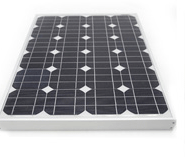size and output of residential PV Systems
Many of the installed residential PV systems are sized to meet 20 to 40% of the electricity needs (the average electricity consumption of American homes is about 11.000-12.000 kWh).
But that's not the right approach.
PV systems should do designed to meed most or all the electricity needs (in new construction). See: Before Installing Solar Photovoltaic.
 Capacity
Capacity
The output of a PV system depends on the size of the array (the number of solar modules, and the area of each one) but also on the type of modules (crystalline or thin film cells).
A 4 kW or a 5 kW photovoltaic system can meet all the needs of energy-efficient single-family homes with a modest size in southern US, but you may need a 6 or a 7 kW PV system in a colder North American climate zone.
Size and output
Obviously, the output of a PV system doesn't depend only on the size and type of the solar module array. It depends also on...
- the number of hours of sunlight in your site (largely dependent on your latitude and climate);
- the tilt angle of the modules;
- the direction of your collectors to the winter sun;
- possible strips of shade over the arrays during certain parts of the day and year;
- losses involving the inverter and wiring.
You and your installer should consider carefully all these elements.
Some are very important and structural (in the sense that you can’t change them), especially those involving climate issues and number of hours of sunlight.
But others, while seemingly minor, can also be important: the impact of shade on the output of the collectors; the tilt angle of the modules; the use of a mounting racking systems; issues like adjustable and rotating racks... See: Racks and Trackers for Solar Collectors
Estimating your PV system output
You can make a broad estimation of the output of a solar PV system, by considering two main structural factors:
1) the size and the peak output of the modules of your array (their wattage) and
2) the average number of sunlight in your area (given by your latitude).
You can use an online calculator for a broad estimation of the output of your PV system, based on these factors. But you may want a more accurate estimation, by considering other factors mentioned above: the tilt of the collectors, the exposure of your collectors to the sun, etc.
To help you doing it, you may use the PVWatts calculator, from the National Renewable Energy Lab. It’s simple to use, and not just intended to help American homeowners; the current version of this calculator has now a module to allow people from other parts of the world to make accurate estimations of their PV system output.
Which size should you consider for your system
The goal of many homeowners, when installing a PV system, is to reduce their electricity bills by 20%, 30% or 40%... But it's not the right approach, especially in new homes.
You should aim more, much more. A PV system only becomes really interesting when designed to meet most all the needs or most of the needs of a home.
And to get it you do not have to invest in a very large PV system; that’s not the goal. That would be a wrong approach and would make the investment too expensive and non-cost-competitive. Your strategy should be to reduce your electric consumption as much as possible, by implementing energy-efficiency improvements in your home. See: Before Installing a Solar Photovoltaic System.
![]() Related Content
Related Content
![]() Top .... Home Page
Top .... Home Page


